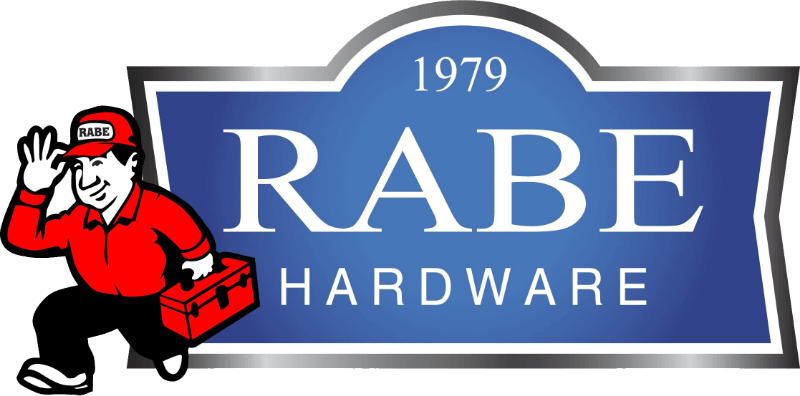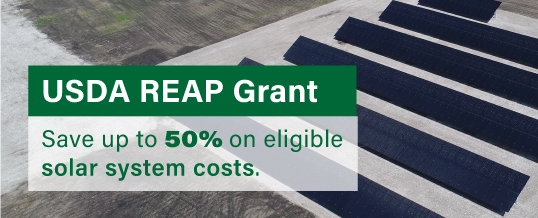As a company operating in rural Iowa, the heart of farm country, we are always looking for opportunities that help our farmer friends and neighbors in the ag industry save money, combat rising electric rates and create greater business predictability. That is why we are on a mission to let every Iowa farmer and rural business know that now is the time to invest in solar power!
Solar not only generates enough electricity from the sun to significantly offset operating costs now and for decades to come, but it also provides a stable alternative to rising energy costs and unpredictable revenue streams. While solar provides long-term savings backed by a guaranteed ROI, the financial incentives have never been better!
Farmers can NOW SAVE 50-80%
on solar installation costs when they take advantage of:
USDA Rural Energy for America Program (REAP) Grant
The USDA developed this program to provide financial assistance to farmers and rural businesses for the purchase and installation of energy efficiency and renewable energy projects. One of the key benefits of the USDA solar energy program is that it can significantly accelerate the return on investment (ROI) for ag based solar systems.
- Under recent updates to the Inflation Reduction Act, the USDA REAP Grant program can save you up to 50% on eligible system costs, ranging from $2,500 to $1,000,000 maximum.
Another key benefit of the REAP Grant is that it can be used in conjunction with the following financial incentives:
-
30% Federal Investment Tax Credit
The current federal Solar Tax Credit is 30% and is available on systems placed in service before 1/1/2033. Systems do not have to be installed at the taxpayer’s principal residence.
-
Commercial Rapid Depreciation
Also known as the Modified Accelerated Cost-Recovery System (MACRS), this federal program allows companies to recover renewable investments through depreciation deductions with an additional 50% first year bonus depreciation for systems placed in service before January 1, 2018.
-
No Iowa Sales Tax
No Iowa sales tax means a 7% savings on a solar installation.
Combining all these incentives greatly reduces the payback period on a solar installation, making solar an attractive investment opportunity for the Iowa agricultural industry. We know this all sounds too good to be true… but we promise, it’s just that good!
Whether drying crops, heating buildings or powering watering pumps; Rabe Hardware’s knowledge and experience will ensure you get the greatest return on your solar investment. From the start, our grant writer will provide turn-key services to maximize funding for your project. From document preparation and submission to post award management, our grant-writer will help you navigate the process. Ready to get started?
Contact Us Today!
USDA REAP Grant Facts
What is it?
$300 million in funding in the 2018 Farm Bill and 2022 Inflation Reduction Act for FY 2023 for renewable energy and energy efficiency projects.
How much can I get?
Up to 50% of eligible costs.
Who is eligible?
Agricultural producers and rural small businesses.
What is an agricultural producer?
Operation with at least 50% of gross income coming from agricultural operations.
What is a rural small business?
Small businesses (an entity or utility, as applicable, that meets Small Business Administration’s (SBA) definition of Small Business) in eligible rural areas (an area other than a city or town with a population of greater than 50,000 inhabitants and the urbanized area of that city or town.)
How/when do I get funds if awarded?
REAP grant is a reimbursement grant that is paid to awarded applicants once project is operational.
What costs are eligible?
Eligible Project Costs are only those costs incurred after a Complete Application has been received by the Agency.
These include but are not limited to:
(1) Purchase and installation of new or refurbished equipment.
(2) Construction, Retrofitting, replacement, and improvements.
(3) EEI identified in the applicable Energy Assessment or Energy Audit.
(4) Fees for construction permits and licenses.
(5) Professional service fees for Qualified Consultants, contractors, installers, and other third-party services.
(6) For an eligible RES in which a residence is closely associated with the Rural Small Business or agricultural operation the installation of a second meter to separate the residence from the portion of the project that benefits the Rural Small Business or agricultural operation, as applicable.
What costs are ineligible?
Ineligible project costs for RES and EEI projects include, but are not limited to:
(1) Agricultural tillage equipment, Used Equipment, and vehicles.
(2) Residential RES or EEI projects;
(3) Construction or equipment costs that would be incurred regardless of the installation of a RES or EEI shall not be included as an Eligible Project Costs. For example, the foundation for a building where a RES is being installed, storage only grains bins connected to drying systems, and the roofing of a building where solar panels are being attached.
How can I apply for a grant?
Applications for this program are accepted year round at your local USDA Rural Development office.
After application is submitted, how long until I know?
The notification period has been highly variable, but 6 months is a reasonable expectation.
If I’m not awarded in the first reviewing period, am I done?
No. Your application remains in competition for at least another round of competition for funding.
Can I build my project once the grant is submitted?
YES. Once your application has been submitted to USDA Rural Development and it is complete, your project may be constructed and completed.
Why does USDA Rural Development do this?
This program helps increase American energy independence by increasing the private sector supply of renewable energy and decreasing the demand for energy through energy efficiency improvements. Over time, these investments can also help lower the cost of energy costs for small businesses and agricultural producers.
What do I need to get started?
Use of a grant writing consultant will greatly simplify this process for you. You will need to obtain a Unique Entity Identifier and CAGE Code # through a SAM.gov registration (if you and/or your business do not already have them). There is supporting documentation that you will need to provide to demonstrate your eligibility as an applicant.

